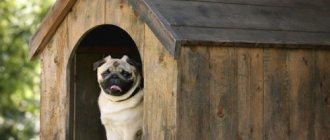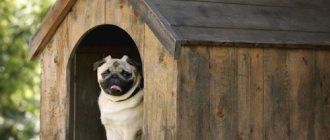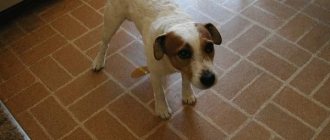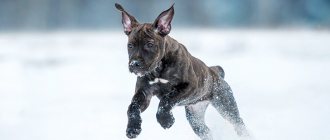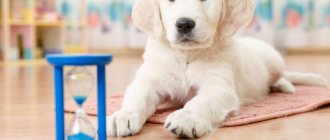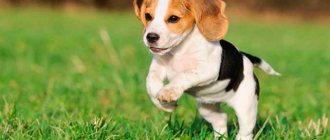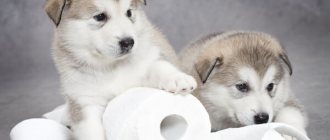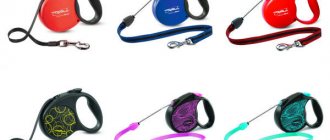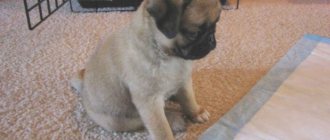Basic requirements for housing on the street
To arrange a new home for a dog, you should adhere to the following rules:
- Make the enclosure or kennel spacious, clean, darkened, and well ventilated (no drafts). The height of the viewing opening should be approximately 75% higher than the length from the animal's shoulder to the ground.
- The door is made using a piece of rubber, tarpaulin, with cut longitudinal strips with weighted ends. This will allow the dog to see what is going on outside and stay inside.
Breeds with thick coats and short muzzles are more sensitive to heat exhaustion. A home that provides sufficient shade and optimal flow of fresh air will suit them.
Providing a safe place is important, especially if the dog lives on the street and will spend long periods of time there. A properly built kennel can protect a dog from extreme temperatures, wind, rain, snow, and potential predators.
There are two types of enclosures:
- Open – a fence installed around the sleeping area. The structure will be useful for limiting the pet while guests arrive.
- Closed - with a roof, mesh walls, doors. There is a kennel inside.
It is recommended to lay a floor in the room reserved for the dog for additional insulation. Usually it is made of concrete (with wooden flooring) or asphalt, and also inclined so that puddles do not form during washing and after rain.
Experts recommend covering the roof with bitumen shingles (to protect against rain or hail).
The doors of the enclosure must open inward and be strong. It is better to choose a strong lock (so that the dog cannot knock it out).
General requirements for outdoor enclosures:
| Dog height | Room area |
| More than 65 cm at the withers | 10 m² |
| 50-65 cm | 8 m² |
| Up to 50 cm | 6 m² |
Description of the breed
German Shepherds are medium-sized dogs with strong bones and well-developed muscles. They have a long wedge-shaped head with a slightly convex forehead, powerful jaws and dark almond-shaped eyes.
The paws of representatives of this breed are straight, set parallel to each other, the ears are triangular in shape, erect.
The height at the withers for males is 60-65 cm, they weigh 30-40 kg, females grow to 55-60 cm with a weight of 22-32 kg.
The coat is dense and hard, short on the head and front of the paws and slightly longer on the neck, with undercoat.
The breed standard allows the following color options:
It is acceptable, but not desirable, to have small white spots on the chest and light colored fur on the inner surface of the body..
Read more detailed characteristics of German Shepherds here.
Why doesn't a dog want to live in a kennel?
A pet may not want to sleep or live in a kennel for various reasons, but all of them can be easily eliminated.
- The animal may not like the smell of the home or some object inside. It is enough to get rid of the unpleasant aroma or something that irritates the dog, and the problem will be solved.
- If the booth is not new (another pet previously lived in it), then the animal may be uncomfortable being there.
- When a dog does not come into his kennel even in the rain, the house may be too small for him (paws, head sticking out of the kennel).
- The dog may be lonely, so you should periodically communicate with it, play, and take it for a walk. Then he will understand that we still love him and will not protest.
- If a stray dog was taken into an apartment, and now the owners plan for it to live in a kennel, you should pay more attention to it, as it may think that it has been put out on the street again.
Dogs with short hair are prone to frostbite and have difficulty withstanding cold temperatures.
The right diet
An important element of proper care and maintenance is a balanced diet. There are two options for feeding a German Shepherd:
A natural diet includes meat, grains, vegetables and fruits. For animal protein, preference should be given to veal, chicken and turkey. Pork should not be given. Porridge should make up no more than 30% of the diet. Add a tablespoon of vegetable oil to them.
Fish, cleaned of bones, is given when the shepherd dog is one year old. The puppy’s diet contains fermented milk products: cottage cheese and kefir. Once a week you can add the yolk of one chicken egg to your food. Finely chop or grate vegetables and fruits. Bread, sweets, and spices should not be given.
German Shepherd puppies have very long hind legs. Therefore, it is recommended to add fertilizer containing calcium and phosphorus to the natural diet. This way you can avoid joint problems and rickets.
With the second feeding option, preference should be given to premium food. They are rich in all the vitamins and minerals a German Shepherd needs. Food should be selected according to the age and size of the German breed dog.
Training methods
Expert opinion
Anna Abramenko
An avid dog lover. Experience in veterinary medicine since 2009.
Ask a Question
It is not easy to train an adult dog to stay in a kennel. If she won't go to the kennel, the following tips will help solve the problem.
- The animal needs to be allowed to get used to it, allowed to enter a new booth, sniff the surrounding area, and wait until it gets used to the enclosure. To do this, you should gradually leave the house with him in dry, warm weather and introduce him to his future home.
- When a dog enters a new home, it is important to reward it with a treat to develop pleasant associations.
- It is worth putting several of your favorite dog toys in the kennel so that the animal can feel a familiar smell.
- When the dog is in the kennel, it is important not to forget about it and not leave it alone. A simple game and communication will reinforce positive emotions.
- It is better to accustom an animal to a new place in warm weather, since in winter being outside can become stressful for him.
The kennel or enclosure is placed facing the front door so that the owner, if necessary, can quickly assess the dog’s condition.
Relationships with children
A representative of this breed treats children very tenderly and carefully. She will never hurt a child and has great patience. Of course, you should not allow your child to abuse the shepherd’s patience by pulling its tail and trying to hit it.
In extreme situations, an animal may well protect a small child from danger and protect him from outside attacks. It takes excellent care of the children as if they were their own. Of course, all this can be achieved only with proper upbringing of the pet.
Arrangement of the booth
First, choose the material for the kennel: wood, metal, plastic. Plastic buildings are usually lighter and cheaper. They are quite easy to transport, they do not rot, do not require painting, and are easy to wash.
Wood buildings are stronger, more durable, and a better insulator than plastic, so your dog is less likely to overheat inside the kennel. But wood has one significant drawback - rotting.
In addition to plastic and wooden ones, there are also iron booths. They are durable, easy to care for, but uncomfortable and bulky.
The roof of the booth must be strong and airtight.
You should definitely consider ventilation; for this you can put the kennel on a pallet or legs.
It is better to choose polystyrene foam as room insulation. They are easy to use, lightweight, and have high thermal insulation properties. Felt is also used instead: it is durable and has good vapor permeability.
The bedding for the booth should not be too large or small. The material is also important for her. Blankets, towels, carpet, hay, straw, and newspapers often become moldy. Fleas and bedbugs will live in them.
The best bedding option is pillows filled with cedar shavings, as the oil from this tree will repel insects. However, it can cause allergies in dogs. To minimize this possibility, fill a small bag with cedar shavings and place it in the kennel to repel fleas and bedbugs.
Control your emotions when breaking up
Many inexperienced owners say goodbye to their pet too emotionally when they intend to leave him alone in the enclosure. By this they themselves encourage the pet to be nervous and afraid of this moment. As a result, the prospect of being left alone makes him anxious.
Don't repeat this mistake. When you leave, tell your dog in a calm voice to stay in the enclosure. Do not reassure with words: “Stay here, my dear, I won’t be long and will come soon.” The dog does not understand the content of this phrase, but he perfectly detects the alarming, pitiful notes in your voice. That is why he begins to get nervous and prepare for the test.
When you return, you can not hold back your emotions and show them in full force, especially if you have been away for a long time. Play with your dog, give him a piece of food he likes. Tailed friends quickly get used to this way of life if the owner does not make mistakes and behaves consistently.
What not to do
When training a dog to a booth or enclosure, dog breeders should not carry out the following actions:
- Forcing your dog into a kennel, as this will only scare him. It is better to slowly, carefully find out what caused this behavior.
- Overwork, force you to repeat the “place” command. It is advisable to gradually increase the intervals of stay in the booth, and the rest of the time to give the animal freedom.
- Overindulge. Everything needs moderation.
- Punish inside the kennel, force the pet into the enclosure.
Vaccination
When keeping a German Shepherd, it is important to pay close attention to the vaccination of your pet.
Dogs are constantly outdoors, in contact with other animals and the environment. To avoid infectious diseases of your pet and parasitic infection, it is important to give him all timely vaccinations.
The first vaccination for a German Shepherd puppy is given at one month of age. After vaccination, the dog must be especially carefully cared for: check his temperature, do not overcool him. The next vaccine is administered after a month.
The puppy's last vaccination is given at the age of 4–7 months. After this, the baby is allowed to walk outside. Further, routine vaccination should be carried out annually.
Aviary for rest
An enclosure for a dog (photo above) as a place to rest is a good option, because animals do not like to get their bed dirty. And if you introduce it to your pet correctly, he will not view the crate as a punishment. Everything will turn out exactly the opposite - this will be his shelter, a safe place.
When choosing an aviary, you need to consider several nuances.
- Select a cage of the appropriate size. The dog should be able to lie down and turn around, but without excess space. If the crate is too large, the puppy may use one end as a toilet, which will delay potty training.
- Use a large drawer and dividers. If you are purchasing a crate for an older dog, dividers can help the space “grow” with the dog.
- Associate it with good experiences (put treats there, feed it there, put your favorite chew toys there), then the pet will soon fall in love with its personal space.
- Reward him for going to his place. The aviary is great for relaxing, do not use it for punishment.
- Take your dog directly to the toilet area when you let him out of the crate.
The third reason is illness
What should you do if your dog shits in the enclosure, but previously only relieved itself outside? Contact your veterinarian immediately for help, your pet is probably sick.
The thing is that recently dogs are often switched exclusively to dry food, citing the fact that it is healthy and contains a whole complex of vitamins that contribute to the proper development of the dog. Of course, this is true: dry food does contain vitamins, it is nutritious, and dogs love it very much. But no one pays attention to the fact that it leads to various diseases, including the urinary system.
If your dog is faced with this disease, then he will go to the toilet often and, possibly, in the wrong place. Don't scold him; your pet is most likely incontinent.
Teaching the command “Place!”
Training your dog to learn this command is quite easy. You need to put a treat in the booth and invite the animal to get it, while saying the word “Place” loudly. After repeating the manipulation several times in a row, take a short break. After some time, the fun game is repeated again, but the treat is placed in the booth every other time.
Additional Information! When teaching a command, you need to choose the right moment when the animal is in a playful mood, it is cheerful and active.
It is quite difficult to train a pet to stay in a kennel. This is a labor-intensive process that requires a lot of effort and patience. To achieve success, you need to act persistently but gently. Through joint games and treats, the owner can show that the booth is very good, comfortable and cozy.
Control
It is very important to constantly monitor the dog, this is also the key to successful training. You cannot prevent accidents if there is no direct contact. This section has some tips to help with supervision.
- If you have organized a toilet for your dog in the enclosure, take him to the potty as often as possible. For small breeds, intervals between attempts may be as little as 15 minutes.
- Set a timer that will notify you when it is time for your pet to go to the toilet. This is necessary in case you forget about new responsibilities, as a result of which “accidents” occur.
- Monitor your puppy to learn to recognize the signs that he wants to go to the toilet. Very common occurrences include sniffing the ground, circling in one place, or whining. When you notice these signs, take your pet to the bathroom immediately.
- If you are busy with something and cannot keep the dog in sight all the time, then a long leash that is wrapped around the waist will come to the rescue. This way you limit the space for the dog, and he is always in your field of vision. This option is suitable for those who have an aviary in their home.
How to properly furnish a new home
It is advisable that the booth be located opposite the entrance to the house - this way the dog will be able to see its owners more often. It should not be located in a low area, otherwise water will flow inside due to rain or melting snow. For additional protection against flooding, you can place it on small supports.
There should not be a barnyard, garage, workshop or other structures with strong odors nearby.
It is important to choose the correct dimensions of the structure. The animal, sitting inside, should slightly touch the ceiling with the tips of its ears, and, if desired, be able to stretch out to its full height on the floor. If the structure is smaller, the dog will feel cramped and uncomfortable, and a dwelling that is too spacious may freeze in winter.
Many dogs like to sit on the roof, so it is advisable to make it with a slope of no more than 10 cm. It is advisable that it be removable or folding - this makes cleaning easier.
The entrance hole should be slightly lower than the dog’s withers in height and 2–3 cm higher than the width of its shoulders. It is advisable to have a sun canopy over the entrance.
A puppy kennel is made with a reserve, focusing on the dimensions of an adult dog.
The design must be protected from leaks and drafts, otherwise the pet will not only feel uncomfortable, but may also get sick.
The roof needs to be covered with roofing felt. All boards should fit snugly against each other. It is desirable that they be pine. It is best to make double walls, and lay foam or felt between them. Sand the wood thoroughly to ensure no splinters remain. Do not use paints or varnishes with a strong odor.
The floor should also be thick, dense, and protected from freezing. Cover it with straw, cover it with a tarpaulin, and lay bedding on it, which has already been used before and smells like a dog.
Root cause of the problem
First you need to understand why your pet does this. In fact, there can be a huge number of reasons. The issue discussed in the article concerns destructive behavior both in the home dog enclosure and in the house itself (relief on the sofa is not such a rare occurrence).
As soon as you get a pet, you need to provide it with a place for the toilet. This must be done, because you can’t walk him now, he has not yet completed the full range of vaccinations. Contact with infected animals can have disastrous consequences. This is the first piece of advice regarding the long process of stopping your dog from crapping in the kennel.
It is better to lay out newspapers or diapers in the place reserved for the toilet. You can also use specially designed toilets for dogs. As soon as your pet has been vaccinated, begin teaching him to relieve himself while walking. It should be one specific place, and not anywhere.
DIY foundation
To build an enclosure, a foundation is required. Thanks to it, the building will not deteriorate from moisture accumulation, sag and will last longer.
The depth of the foundation is 1-1.5 meters, the area is 6-8 m2 depending on the size of the husky . The bottom of the pit should be lined with a layer of stones and secured with concrete.
To create the latter, mix cement, water, sand, crushed stone in a ratio of 1:1:2:3 and fill the bottom of the pit with the resulting mass.
The cement mortar will dry in about 72 hours. If the ground is soft or clayey, you should strengthen the edges of the hole with boards.
After creating the cushion, it is necessary to fill the foundation with cement mortar so that it rises 10 cm from the ground level . To protect against moisture, it is recommended to waterproof with roofing felt.
What to do if your puppy cries at night
There is no use in tearing out your hair. It's better to make an action plan. Perhaps our advice will help you. On a scale of 10, how hard is raising a small puppy? Many answer: “11 points.” But there is good news: it will soon become easier, and your hard work will pay off in a big way. Many dog owners compare raising puppies to caring for a baby, and they are right.; This article is dedicated to all puppy owners whose pet cries at night or does not want to fall asleep at all.
Why train a dog to a chain?
From the very beginning, the owner must understand why he should accustom his pet to a chain. If the dog’s main task is to bark at strangers and scare them away, then it would probably be more humane to equip the yard with a video surveillance system with an alarm. And a dog, which will be severely limited in its movements around the territory, will not be able to protect it properly. If your dog just sits on a short chain, he will not become a hindrance to intruders who set themselves the goal of breaking into the house. When leaving your house unattended, do not expect a dog on a chain to protect it. Attackers often poison chained dogs to carry out their dirty deeds. And for such dogs, packs of stray dogs roaming freely pose a danger. Therefore, in attempts to drive away strangers, animals on chains sometimes strangle themselves with their own chains.
If your goal is to raise a real guard dog, then you will have to put a lot of effort into this. The dog must distinguish its own from strangers and obey commands unquestioningly. And in this case, there is no need to train the dog to sit on a chain all the time. You will need to tie him up only when guests come to you, other people who will be unpleasant to see the dog barking and running after them. And in order for your student to be calm about temporary deprivation of liberty, he must be raised correctly.
Sequencing
When thinking about how to potty train your puppy, don't underestimate routine and consistency. Establishing a schedule and sticking to it will help prevent accidents and ensure each pup gets to where he needs to go. These tips will help you stay consistent.
- Know when your puppy should relieve himself. Most people need the toilet when they wake up in the morning, after eating, after playing and after sleeping. Therefore, every time one of these events occurs, take him outside to the chosen toilet area.
- Walk your puppy when you think it's time. But don't let him run and play instead of going to the toilet. Instead, bring him back into the enclosure for 10-15 minutes and then try again.
- Feed your pet strictly on a schedule. This way you can more accurately control his toilet time.
Raising puppies - boys and girls: differences and similarities
The training of Alabais, boys and girls, is largely similar, with the exception of some differences.
Alabai females are more sensitive and more often expect concessions from the owner, evading commands. They have less claim to the title of leader in the pack, therefore, as training progresses, they are more obedient.
Males, on the other hand, are considered more aggressive and stubborn, so you should be more stubborn and strong-willed with them. They have a tendency to run away, especially if there is a female dog in heat nearby. Such vagrancy cannot be allowed.
Reference! A clash between two bitches is much more violent than between two dogs.
Patience
Is your dog taking longer to toilet train than you expected? The main thing is patience. Even learning one basic command takes a lot of time, and this is such a difficult question. This section provides several facts about dogs associated with loose toileting.
- A puppy cannot control his bladder until he is 16 weeks old. So no matter how much you want it, he just can't wait long.
- He will not be able to control his bladder until he is 17 weeks or older. Please note that a four-month-old puppy can “hold himself in his paws” for only five hours. Next, add another hour to each month. It's the same time at night.
- Each breed is individual. For example, miniature dogs may need more frequent walks due to their fast metabolism and tiny bladder.
- Each puppy is individual, even within the breed. Your first pet may have been potty trained in a few weeks, but your next one may take months.
